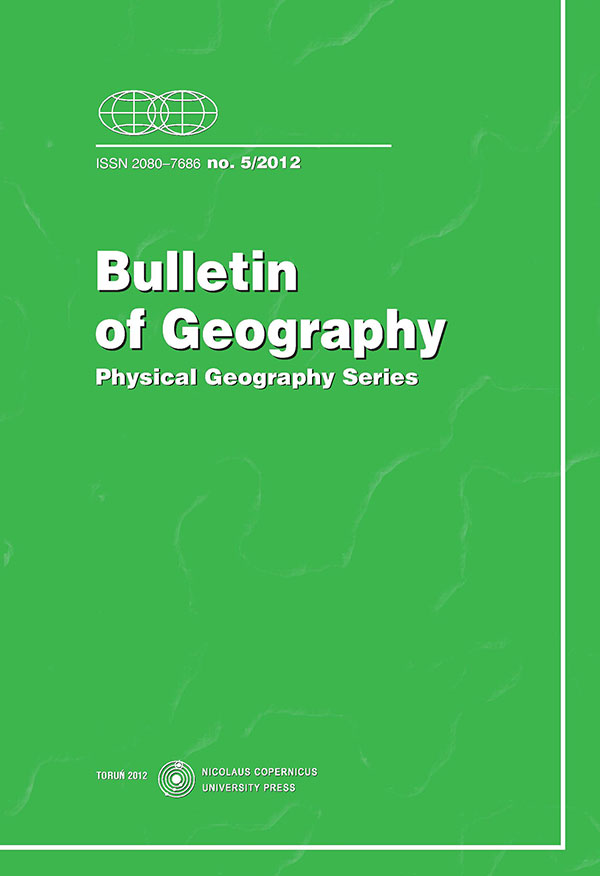Selected Chemical Properties of Necrosols from the Abandoned Cemeteries Słabowo and Szymonka (Great Mazurian Lakes District)
DOI:
https://doi.org/10.2478/v10250-012-0003-8Keywords
Necrosol, abandoned cemetery, chemical properties (Pt, OC, Nt), Great Mazurian Lakes DistrictAbstract
The paper shows the occurrences of cemetery soils and the physico-chemical features of soils in the cemeteries Słabowo and Szymonka (Great Mazurian Lakes District). Necrosols are anthropogenic soils and belong to Urbanosols. They form only in the area of cemeteries. Four soil profiles (Necrosols) were investigated in terms of morphological description and chemical properties especially phosphorus (Pt), organic carbon (OC) and nitrogen (Nt). These profiles were compared with the reference profile (Rusty soil, according to WRB 2007 Brunic Arenosol) made outside the cemetery. On the basis of research Necrosol has been defined as a soil formed by special human activity in cemeteries and burial grounds with specific soil horizon sequence, and also physical and chemical properties.References
BEDNAREK R., DZIADOWIEC H., POKOJSKA U. and PRUSINKIEWICZ Z., 2004, Badania ekologiczno-gleboznawcze, Wyd. Nauk. PWN, Warszawa, 344 pp.
BEDNAREK R., JANKOWSKI M, KWIATKOWSKA A., MARKIEWICZ M. and ŚWITONIAK M., 2004, Zróżnicowanie zawartości fosforu w glebach w obrębie zespołu osadniczego w Kałdusie i w jego otoczeniu, [in:] Wczesnośredniowieczny zespół osadniczy w Kałdusie. Studia przyrodniczo-archeologiczne. Seria: Mons Sancti Laurentii, 2, Wyd. UMK, Toruń, 199-208.
BRZEZIŃSKI W., DULINICZ M. and KOBYLIŃSKI Z., 1983, Zawartość fosforu w glebie jako wskaźnik dawnej działalności ludzkiej, Kwart. Hist. Kult. Material., 31, 277-297.
BURGHARDT W., 1994, Soil in urban and industrial environments, Zeitschrift Planzenernahr. Bodenkunde, 157, 205-214.
CHARZYŃSKI P., BEDNAREK R., ŚWITONIAK M. and ŻOŁNOWSKA B., 2010, Ekranic Technosols and Urbic Technosols of Toruń Necropolis, Geologija, 53, 4(76), 179-185.
GEBHARDT H., 1982, Phosphatkartierung und bodenkundliche Geländeuntersuchungen zur Eingrenzung historischer Siedlungs - und Wirtschaftsflächen der Geestinsel Flögeln, Kreis Cuxhaven - Verlag August des Hildesheim, 1-10.
GERASIMOVA M. I., STROGANOVA M. N., MOŻAROWA H. W. and PROKOFIEVA T. W., 2003, Antropogennyje pochvy (genezis, geografiya, rekul‘tivatsiya), Smolensk, 268 pp.
KONDRACKI J., 2002, Geografia regionalna Polski, Wyd. Nauk. PWN, Warszawa, 450 pp.
MAJGIER L., 2010, Gleby cmentarne na przykładzie porzuconego cmentarza Rudówka Mała (Kraina Wielkich Jezior Mazurskich), III Geosympozjum Młodych Badaczy „Silesia 2010”, Prace WNoZ UŚ, 65, 119-128.
POLISH SOIL CLASSIFICATION, 2011, Roczniki Gleboznawcze, 62, 3.
SMOLIK F., 1957, Pedologie, Praga, 400 pp.
SOBOCKA J., 2002, Klasifikacne principy antropogennych pod SR vo vzt’ahu podobnym systemom vo svete. Prve podoznalecke dni v SR (book of abstracts) 103-110.
SOBOCKA J., 2003, Urban Soils vs. Anthropogenic Soils, their Characteristics and Functions, Phytopedon, 2, 76-80.
SOBOCKA J., 2004, Necrosol as a new anthropogenic soil type, [in:] Proceedings, Soil Anthropization VII, Bratislava, 107-112.
STROGANOVA M., MYAGKOVA A., PROKOFIEVA T. and SKVORTSOVA I., 1998, Soils of Moscow and urban environment, Moskwa, 178 pp.
WRB, 2007, World References Base for Soil Resources 2006, Update 2007, World Soil Resources Report 103, FAO, Rome, 122 pp.
ŻOŁNOWSKA B., 2006, Charakterystyka gleb wybranych toruńskich nekropolii, MSc thesis (manuscript), Zakład Gleboznawstwa UMK, Toruń.
Downloads
Published
How to Cite
Issue
Section
Stats
Number of views and downloads: 742
Number of citations: 0



